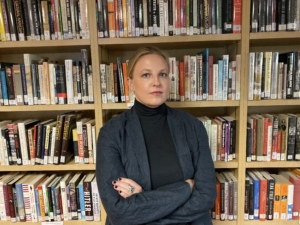Hood Century: Using Architecture and Psychogeography for Community Preservation
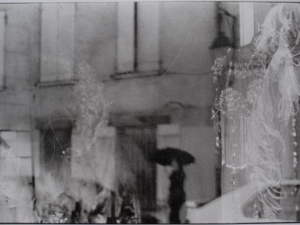
Untitled photograph from the series “Passages Parisienne” by Robert Ogle 1999-2005
I lived in Paris for my undergraduate degree in the mid-2000’s. I learned the city by walking endlessly through narrow streets and grand boulevards. I felt I had an intimate relationship with Paris, like she was my friend during my many solo treks on foot. The notion of people being connected to their urban environment and how they interact with it has been part of my daily thought processes since. How cities influence the human psyche and vice-versa. This fascination eventually led to a degree in urban design in London, where I spent the entire degree designing spaces that inspired wandering and getting lost, sensual connectedness to urban spaces, and spontaneous interactions with the city and other inhabitants. All of these design goals were fused by the notion of radical spatial awareness and corporeal curiosity. I was heavily influenced by The Situationists, a group of avant-garde artists, activists and intellectuals in 1960’s France who believed society had become overwrought with authoritarian capitalism and consumerism. Their idea was to roam aimlessly through the streets as an act of rebellion against insidious societal pressures of a capitalist system. I now live in Los Angeles and do not find myself wandering the streets. Instead, I drive most of the time, which to me, constitutes a dramatic shift in intimacy with the city in which I live.
Last week I was scrolling through Instagram and saw an image of a boxy apartment building on the corner of Greenwich and Laguna in San Francisco describing it as having a “pop-up book feel” and I felt instantly drawn to it. It led me to the account Hood Century – a page devoted to images of mid-century design from the “hood” in cities all over America. I got increasingly excited about the creator’s enthusiasm for architecture, and rediscovering his childhood neighborhood in Cincinnati’s West End through a new architectural lens. As an urban design and urban sustainability practitioner, looking through this page – I realized I had found a fellow psychogeographer. Known as the intersection of geography and psychology, psychogeography emphasizes being radically present with your surroundings as you wander the streets, noticing forgotten or unrecognized elements. This is exactly what the creator of Hood Century, Jerald Cooper, is doing.
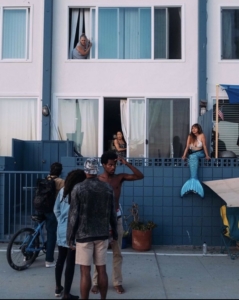
Image from Instagram @hoodmidcenturymodern
Because of the traction on his social media account, he has been interviewed extensively in the last couple of weeks, with stories about him appearing in Architectural Digest and interviewed on WOSU Public Radio. Cooper says he started Hood Century because he believes people who live in the “hood” are disconnected from the architecture around them, specifically mid-century modern. From the late 1930’s to late 1960’s, mid-century modern architecture is known for its futuristic aesthetic with qualities including: a connection to nature with open or glass walls, angular structures with geometrical designs and asymmetrical compositions, and minimalist flat planes over ornate decor.
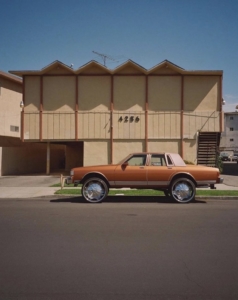
Image from Instagram @hoodmidcenturymodern
Cooper discovered his idea for Hood Century by walking around the neighborhood where he grew up, the West End of Cincinnati. After living in Los Angeles, home to many mid-century modern buildings, he became aware of this specific type of architecture, and it clicked that all over America (and the Caribbean) this architecture existed. It was not just the immaculately preserved buildings iconic to Palm Springs, but also in his hometown. He decided then he wanted to close the gap of architectural knowledge and people living in non-white affluent neighborhoods. He also wanted to make architecture a fun thing to be able to place and not just for architects and academics. Cooper succeeds in his mission through photography and imagery, making it accessible and fun for people to comment and interact with him and one another. His enthusiasm is contagious.
One of the leaders of The Situationists, Guy Debord (known for his book Society of the Spectacle) first coined the term psychogeography, but it is also affiliated with the flâneur, a man meandering the streets observing life, like Charles Beaudelaire. Cooper’s form of psychogeography differs from the original Situationist Movement, particularly in that it has been influenced by the wealth and racial gap in America. The dissent of the original psychogeography was that if you are being present in your environment, you are not being ruled by consumerism. You are liberated from society’s time and space demands. Cooper’s psychogeography seems to me to introduce architecture and its history – open a critical eye – to the people who live in the hood. This helps them connect with their place and community, which in turn will hopefully lead to a sense of ownership, pride, and preservation. Preservation not just for the historic buildings – many of which are shown to be dilapidated in the photos – but for the community. So that when the tides of gentrification come back around, the people in these communities will know the value of their homes and neighborhoods. But I believe that there is still a sense of dissent in taking action against the passivity that a capitalist system requires. Cooper is taking action to preserve and protect systemically marginalized communities and he is also a modern flâneur.
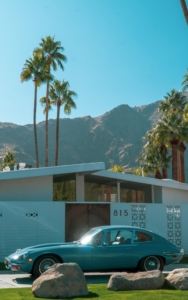
Mid-Century Modern Home in Palm Springs, CA photo by Grant Morris
The rise of mid-century design, mainly from post-WWII until the late 1960’s, became connoted with whiteness and wealth – the world of Don Draper, Mad Men and American suburbia. But Cooper juxtaposes this notion, having imagery of non-white people with mid-century buildings that led Hood Century’s bio to read: Yes!! There is mid-century design in the hood!! I know of a few famous Black architects who designed mid-century modern buildings. Paul Revere Williams is known for designing celebrity homes in Southern California, and I have been to the neighborhood Chatham in the South Side of Chicago, a historically wealthy Black neighborhood known for its mid-century modern homes. But it cannot go without saying, most of the mid-century modern neighborhoods were built for white families given mortgages subsidized by the federal government, or Federal Housing Administration (FHA) loans. Black families were not given these loans under a system of oppression called Redlining. In Richard Rothstein’s book,The Color of Law, he writes: “Our system of official segregation was not the result of a single law that consigned Black people to designated neighborhoods. Rather, scores of racially explicit laws, regulations, and government practices combined to create a nationwide system of urban ghettos, surrounded by white suburbs.”
When the laws (very slowly) changed in the 60’s and 70’s, neighborhoods began to diversify, leading to white folks fleeing to other suburbs. Money was taken out of these neighborhoods, sidewalks unkempt, crime ensuing, buildings not preserved, including historic ones, and communities feeling out of place with the architecture. And, of course, people not strolling down the streets to take in the city and get lost, like the Situationists in Paris reclaiming their autonomy from oppressive factors of capitalism. This act of insurgence they called the dérive, the drift.
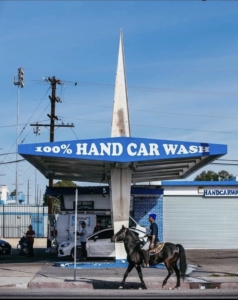
Image from Instragram @hoodmidcenturymodern
Cooper’s solution to the housing disparities and the people in the “hood” not feeling like their homes were really theirs was to create Hood Century and teach people architecture literacy through photos of non-white neighborhoods all over the country that have mid-century design. He also encourages people to go out in their cities and suburbs to wander, observe, and be present with the architecture, to enter the dérive of their own neighborhoods noticing the buildings. His followers send him photos of what they see, or re-see on the very streets they walk every day. One of my favorites is of a mid-century apartment building with a woman in a mermaid costume sitting on a ledge with her shimmering tail against a blue wall. Only one of the seven people depicted in it is white. Another is a photo of a car wash in Compton with a “Compton Cowboy” – a Black man riding a horse down the street – a posse of whom I knew little of their history and now do. Cooper tells us how to access the white Space Age building in the middle of LAX, one of his favorites, built in 1961 by architects William Pereira and Charles Luckman. He even has a constructed image of a pink Guggenheim (Frank Lloyd Wright originally wanted it pink) with Solange sitting atop.
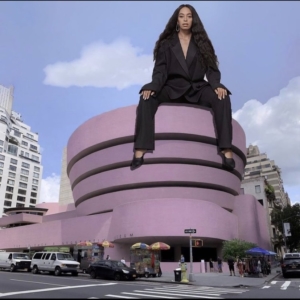
Image from Instagram @hoodmidcenturymodern
Hood Century has redefined how we look at mid-century modern design and it has also questioned what mainstream media portrays as beautiful. Beauty in America has been usurped by whiteness and economic class since Europeans arrived on this land. In her book, Art on My Mind: Visual Politics, bell hooks said: “We need to theorize the meaning of beauty in our lives so that we can educate for critical consciousness, talking through the issues: how we acquire and spend money, how we feel about beauty, what the place of beauty is in our lives when we lack material privilege and even basic resources for living, the meaning and significance of luxury, and the politics of envy.” This is what I feel Cooper is doing with Hood Century: he is ‘educating for critical consciousness.’ I greatly admire his work for the excitement and joy it brings to everyday interactions with the world around us.
Franz is an urban sustainability practitioner and Antioch University MFA graduate. With an international background and previous masters’ in urban design, she concentrates her writing on how cities impact the psyches of citizens. She lives in Los Angeles.

